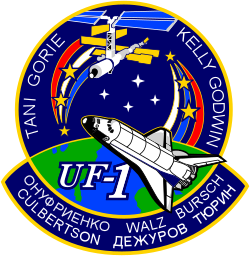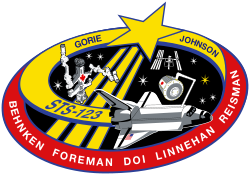Dominic Lee Pudwill Gorie
| Dominic Lee Pudwill Gorie | |
|---|---|
 Dominic Gorie | |
| Astronaut NASA | |
| Státní příslušnost | |
| Datum narození | 2. května 1957 (65 let) |
| Místo narození | Lake Charles, Louisiana |
| Předchozí zaměstnání | námořní důstojník |
| Hodnost | kapitán |
| Čas ve vesmíru | 48 dní, 15 hodin a 19 minut |
| Kosmonaut od | 1994 |
| Mise | STS-91, STS-99, STS-108, STS-123 |
| Znaky misí | |
| Některá data mohou pocházet z datové položky. | |
Dominic Lee Pudwill Gorie (* 2. května 1957 v Lake Charles, stát Louisiana, USA) je americký námořní důstojník a kosmonaut. Ve vesmíru byl čtyřikrát.
Život
Studium a zaměstnání
Absolvoval střední školu Miami Palmetto High School v městě Miami na Floridě a pak pokračoval ve studiu na vojenské námořní akademii US Naval Academy v Annapolis. Ukončil jej v roce 1979. Působil pak jako pilot na řadě míst. V roce 1987 absolvoval školu testovacích pilotů a pokračoval ve vysokoškolském studiu na University of Tennessee v Knoxville. Studium ukončil v roce 1990 a dál působil v armádě.
V letech 1995 až 1996 prošel výcvikem budoucích astronautů v Houstonu a v letech 1996 až 2010 byl členem tamního oddílu astronautů NASA.
Oženil se, jeho manželkou se stala Wendy Lu, rozená Williamsová. Mají spolu dvě děti, Kimberly a Andrewa. Má přezdívku Dom.
Lety do vesmíru
Na oběžnou dráhu se v raketoplánech dostal čtyřikrát, pracoval v orbitálních stanicích Mir i ISS a strávil ve vesmíru 48 dní, 15 hodin a 19 minut. Byl 379. člověkem ve vesmíru.
- STS-91 Discovery (2. června 1998 – 12. června 1998), pilot
- STS-99 Endeavour (11. února 2000 – 22. února 2000), pilot
- STS-108 Endeavour (5. prosince 2001 – 17. prosince 2001), velitel
- STS-123 Endeavour (11. března 2008 – 27. března 2008), velitel
Odkazy
Externí odkazy
 Obrázky, zvuky či videa k tématu Dominic Lee Pudwill Gorie na Wikimedia Commons
Obrázky, zvuky či videa k tématu Dominic Lee Pudwill Gorie na Wikimedia Commons - Na webu Space
- Na webu MEK-Kosmo
Média použitá na této stránce
This is the mission patch of STS-108. Space Shuttle Endeavour is seen approaching the International Space Station. Two astronaut symbols represent the crew commanders of both ISS expeditions. The ascending one represents cosmonaut Yury Onufriyenko of Russia. (The ascending astronaut symbol shows a flag of Russia.) The descending astronaut symbol represents Frank Culbertson of the USA. This represents crew rotation, as three stars are depicted on the symbols. The space shuttle crew members are depicted along the border while the ISS crews are depicted along the chevron on the border of the patch.
- This is the insignia for the STS-108 mission, which marks a major milestone in the assembly of the International Space Station (ISS) as the first designated Utilization Flight, UF-1. The crew of Endeavour will bring the Expedition Four crew to ISS and return the Expedition Three crew to Earth. Endeavour will also launch with a Multi-Purpose Logistics Module (MPLM) that will be berthed to ISS and unloaded. The MPLM will be returned to Endeavour for the trip home and used again on a later flight. The crew patch depicts Endeavour and the ISS in the configuration at the time of arrival and docking. The Station is shown viewed along the direction of flight as will be seen by the Shuttle crew during their final approach and docking along the X-axis. The three ribbons and stars on the left side of the patch signify the returning Expedition Three crew. The red, white and blue order of the ribbons represents the American commander for that mission. The three ribbons and stars on the right depict the arriving Expedition Four crew. The white, blue, red order of the Expedition Four ribbon matches the color of the Russian flag and signifies that the commander of Expedition Four is a Russian cosmonaut. Each white star in the center of the patch represents the four Endeavour crew members. The names of the four astronauts who will crew Endeavour are shown along the top border of the patch. The three astronauts and three cosmonauts of the two expedition crews are shown on the chevron at the bottom of the patch.
STS099-(S)-001 (JUNE 1999) STS-99 INSIGNIA -- The crew members designed the flight insignia for the Shuttle Radar Topography Mission (SRTM), the most ambitious Earth mapping mission to date. Two radar antennas, one located in the Shuttle bay and the other located on the end of a 60-meter deployable mast, will be used during the mission to map Earth's features. The goal is to provide a 3-dimensional topographic map of the world's surface up to the Arctic and Antarctic Circles. The clear portion of Earth illustrates the radar beams penetrating its cloudy atmosphere and the unique understanding of the home planet that is provided by space travel. The grid on Earth reflects the mapping character of the SRTM mission. The patch depicts the Space Shuttle Endeavour orbiting Earth in a star spangled universe. The rainbow along Earth's horizon resembles an orbital sunrise. The crew deems the bright colors of the rainbow as symbolic of the bright future ahead because of human beings' venturing into space.
STS-91 CREW INSIGNIA (March 1998) --- This is the crew patch for the STS-91 mission -- the ninth flight of the Shuttle-Mir Phase One docking missions. The crew will bring back Andrew S. W. Thomas, the last long-duration American crew member flown on the Russian Space Station Mir. This mission marks the end of the Shuttle-Mir Phase One Program and will open the way for Phase Two: construction of the International Space Station (ISS). The crew patch depicts the rendezvous of the Space Shuttle Discovery with the Space Station Mir. The flags of the United States and Russia are displayed at the top of the patch and both countries are visible on the Earth behind the two spacecraft. The names of the American crew members surround the insignia on the outer areas, with the name of cosmonaut Valery Ryumin in Cyrillic at the lower right. The Alpha Magnetic Spectrometer (AMS) is an international payload planned to fly in the payload bay of Discovery. Two thin golden streams flowing into the AMS represent charged elementary particles. The detection of antimatter in space will help scientists better understand the physics and origins of the universe.
STS-123 continues assembly of the International Space Station (ISS). The primary mission objectives include rotating an expedition crew member and installing both the first component of the Japanese Experimental Module (the Experimental Logistics Module - Pressurized Section (ELM-PS)) and the Canadian Special Purpose Dexterous Manipulator (SPDM). In addition, STS-123 will deliver various spare ISS components and leave behind the sensor boom used for inspecting the shuttle's thermal protection system. A follow-on mission to ISS will utilize and then return home with this sensor boom. A total of five spacewalks are planned to accomplish these tasks. The mission will also require the use of both the shuttle and ISS robotic arms. STS-123 will utilize the Station-Shuttle Power Transfer System to extend the docked portion of the mission to eleven days, with a total planned duration of 15 days. The crew patch depicts the space shuttle in orbit with the crew names trailing behind. STS-123's major additions to ISS (the ELM-PS installation with the shuttle robotic arm and the fully constructed SPDM) are both illustrated. The ISS is shown in the configuration that the STS-123 crew will encounter when they arrive.





